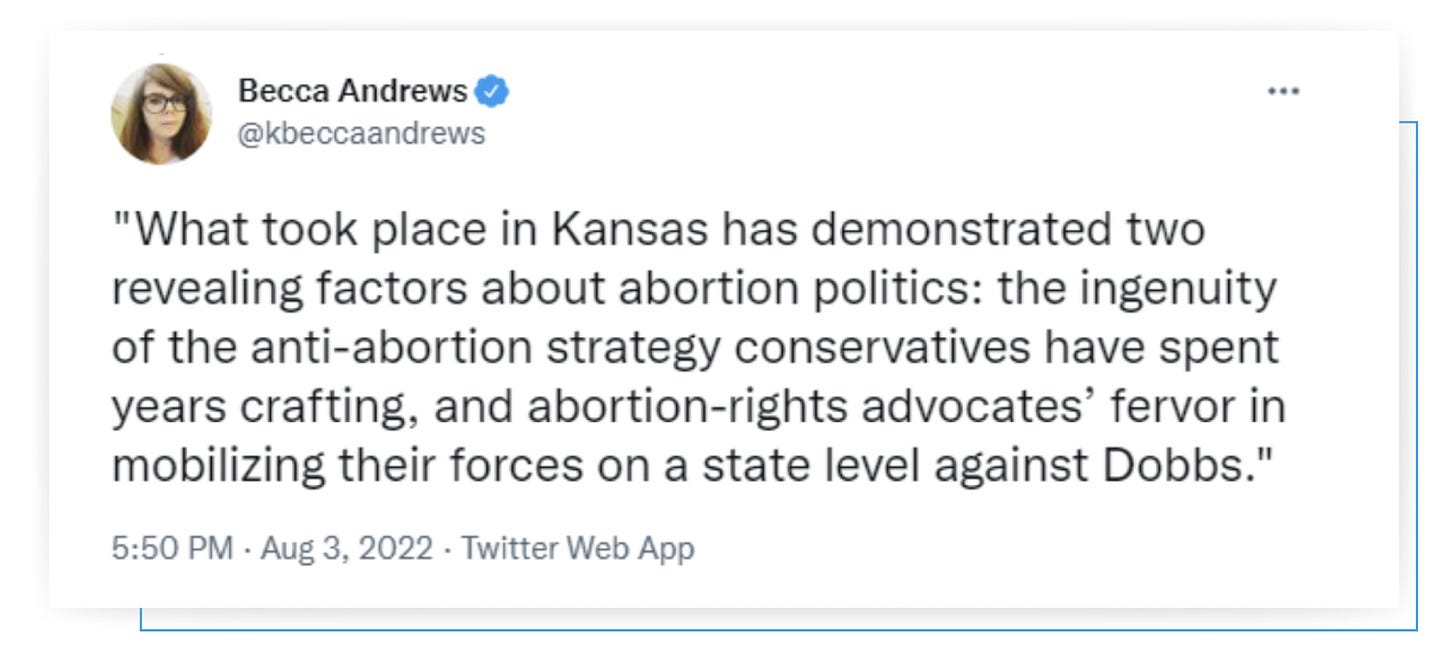It’s Clear Young Voters are Energized Around Reproductive Rights, But How Do We Continue This Momentum Online?
We examined nearly 25 million online messages to gauge how Americans feel about the SCOTUS decision on Dobbs v. Jackson to better understand targeting strategies that can mobilize voters online.
It has now been two months since SCOTUS delivered its devastating decision on Dobbs v. Jackson overturning abortion protections nationwide. Since then we have seen not only outcries from the public over losing something they believed to be a fundamental right but also an eagerness to do something about it. Voters are energized, and we have witnessed this zeal in Kansas where they voted to uphold the protection of abortion rights in their state constitution.
But how do we keep this momentum and spread it across the country? The key lies in targeting the right audience and using language that engages them.
BIG TAKEAWAY: The online discussion about abortion among self-identified Democrats is not reaching the general public’s younger audience, an indication that messaging from the left is not reaching the audiences most likely to mobilize for the cause.
A growing number of younger women are mobilizing around reproductive rights.
Using language that focuses on abortion as essential healthcare and fundamental freedom resonates most with these audiences.
While the online discourse around abortion has decreased since the Dobbs decision, mobilization has not.
SLEEPER TAKEAWAY: The language we use to connect with voters online matters.
In the year prior to the SCOTUS decision to overturn Roe V. Wade, we saw a number of laws passed by states like Mississippi and Texas banning abortions in almost all scenarios. These cases were not only controversial but generated a lot of buzz online over what this could mean for women in the future.
When these fears came true in June, a storm erupted online making the previous year's discourse seem minuscule. And while the online mentions of abortion have decreased notably since the SCOTUS announcement in June, these volumes remain much higher compared to the same 60-day period in 2021.
According to the latest Census data, nearly 1 in 3 women (21 million) have lost access to abortion procedures after 14 states have implemented bans following the overturning of Roe V Wade in June.
Despite the horrendous and wide-reaching effects of the Supreme Court’s decision, it has ultimately led to voters mobilizing across the country.
According to a recent analysis by TargetSmart, there is a growing gender gap in voter registration in key states where abortion rights are threatened. Females under 25 years old are out-registering their male counterparts since the Dobbs decision was announced, a clear indication that the ruling has really fired up the female electorate.
We witnessed this play out in the first big victory for abortion rights activists since June when voters in Kansas cast a ballot on whether the state constitution should continue to protect abortion rights, or if the issue of abortion should be left in the hands of the state’s Republican-controlled Legislature.
This overwhelming victory in a largely conservative state is further indication that the abortion polls are correct - the majority (58%) of voters disapprove of the decision to end constitutional rights to abortion.
And again just last week when Pat Ryan’s victory in the special election for the 19th District in New York proved that running on a platform with strong messaging about protecting reproductive rights can really make a difference in this election cycle.
This activity makes it clear that our target demographic for online engagement, if we want to see action at the polls, would be women under 25. But the online discourse shows that Democrats are missing the opportunity to capitalize on this momentum.
The online discussion about abortion among self-identified Democrats skews much older than the general public - an indication that messaging from the left might not be reaching those audiences most likely to mobilize for the cause.
In order to engage with our desired target audience, we should look at the language they most frequently use and that also generates the most engagement.
We have found online previously that when abortion is discussed in terms of freedom the age distribution shifts to a much younger audience, and this is still true. Messaging that focuses on the threats to the freedom of choice and freedom to control your own body resonates most strongly with those under the age of 34.
Additionally, online users have increasingly been speaking about abortion bans in terms of denying access to essential healthcare. Not only does this messaging resonate with younger audiences but also generates more positivity online when compared with general mentions of abortion or mentions of abortion and freedom.
Bottom line: If the goal is to call voters to action we need to ensure we are targeting the most energized groups using the language they resonate with most. In the case of reproductive rights Democrats should lean into young, female audiences focused on abortion as a fundamental freedom and basic healthcare.
Enjoying What the Polls Don’t Tell Us? Check out our newest edition: If Brands Put People First.
Real people with real opinions and experiences make up a brand’s audience; yet, there is a disturbing lack of real people in brand campaigns.
“If Brands Put People First,” is a biweekly newsletter where we will examine campaigns, advertisements, and commercials from brands that we think could make a major impact if they used real people, with real stories, to achieve real results.
Interested? Subscribe Here















